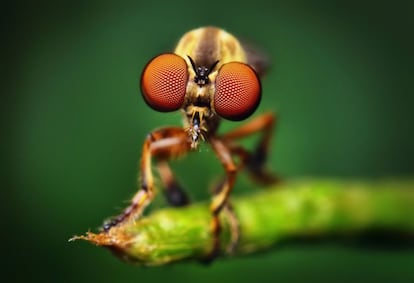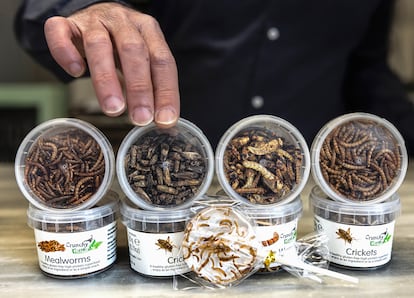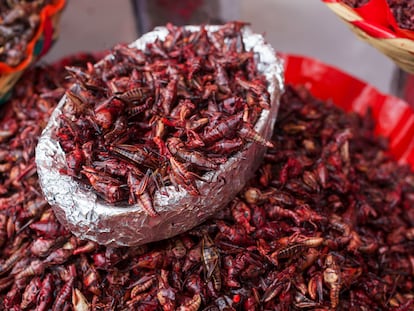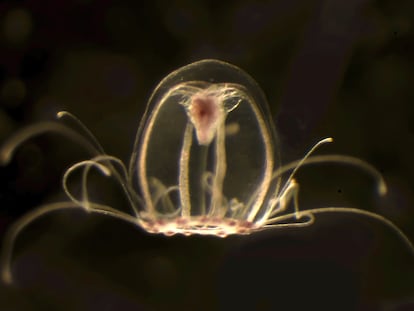What if insects could feel pain?
A review of studies confirms that these arthropods have the necessary mechanisms to suffer, which would alter the plans to turn them into food

So far, around a million species of insects have been counted in the world. However, the Royal Entomological Society of London estimates that, in total, there could be up to 10 million. Nonetheless, despite the large number of species of these arthropods that exist, they have not always been studied to the same extent as other animals, according to José Carlos Otero, Professor Emeritus Ad Honorem at the University of Santiago de Compostela in Spain. But this is changing: “Now they are beginning to be studied a lot because we are realizing that they are absolutely necessary for the survival of the human species, that is, that many things that the ecosystem services provide us come from the insects,” he explains. Recently, a group of researchers tried to provide an answer to a debate that has been open for several years: are insects capable of feeling pain? For this, they reviewed the available literature, whose conclusion confirms that insects do have the necessary mechanisms to experience suffering. However, these results – they explain – are not definitive proof, and must be complemented in the future with further behavioral, psychological and hormonal work
Lars Chittka, Professor of Sensory and Behavioral Ecology at Queen Mary University of London and one of the authors of the study, explains that it is important to be certain about this matter at a time in which the insect industry is growing as an option of consumption for people, as well as for livestock. In 2013, the Food and Agriculture Organization of the United Nations recommended eating insects to fight hunger, and defined these animals as an important and easily accessible source of nutritious, protein-rich food.
The researcher, who recently published a book entitled The Mind of the Bee, asserts that there is no legal framework for the use of these insects in the case of the industry, but neither in the case of research, and he urges to properly understand what happens with them before the same mistakes that happened with the raising of other animals, like the case of chickens, are repeated. Otero also advocates for the legislation of this matter, especially the way of slaughtering them, as he is convinced that they do suffer.

Nociception is the sensory mechanism that allows animals to sense and avoid potentially harmful stimuli, according to research published in Current Biology. An example of this concept happens when one is exposed to something very hot and specialized receptors in the skin respond to that stimulus to quickly move away from it. This is present in all animals, Chittka points out, and has been extensively studied in insects. But nociception is not necessarily evidence that the animal actually experiences some kind of subjective sensation of unpleasantness in its mind; that is, pain.
It is important to distinguish between this reflex response and pain. Although the nociceptive responses are almost automatic – explains the author – a reflex of the control of the central nervous system of peripheral sensation shows that it is flexible and can be controlled from the brain. To put it in simple words, he uses the example of a wounded soldier on a battlefield that is not aware of an injury until he returns to his shelter: this is a consequence of his endogenous opiate system. In that sense, the existence of this kind of central nervous modulation of the sensation of a potentially harmful stimulus can be proven, indicating that there is plasticity that comes with actual pain, not just with the perception, he adds. And this is what they have concluded that insects have. Neural pathways and molecular building blocks are necessary in this process.
In addition to analyzing if insects suffer from pain, a team of researchers went a step further and published a study in 2019 stating that some of these animals can experience chronic pain, which lasts long after an initial wound has healed. In this research, published in the scientific journal Science Advances, they damaged a nerve in the leg of a fruit fly. Once the wound healed, the fly’s other legs had become hypersensitive.
Tu suscripción se está usando en otro dispositivo
¿Quieres añadir otro usuario a tu suscripción?
Si continúas leyendo en este dispositivo, no se podrá leer en el otro.
FlechaTu suscripción se está usando en otro dispositivo y solo puedes acceder a EL PAÍS desde un dispositivo a la vez.
Si quieres compartir tu cuenta, cambia tu suscripción a la modalidad Premium, así podrás añadir otro usuario. Cada uno accederá con su propia cuenta de email, lo que os permitirá personalizar vuestra experiencia en EL PAÍS.
¿Tienes una suscripción de empresa? Accede aquí para contratar más cuentas.
En el caso de no saber quién está usando tu cuenta, te recomendamos cambiar tu contraseña aquí.
Si decides continuar compartiendo tu cuenta, este mensaje se mostrará en tu dispositivo y en el de la otra persona que está usando tu cuenta de forma indefinida, afectando a tu experiencia de lectura. Puedes consultar aquí los términos y condiciones de la suscripción digital.
More information
Últimas noticias
Most viewed
- Charles Dubouloz, mountaineering star, retires at 36 with a farewell tour inspired by Walter Bonatti
- The Florida Keys tourist paradise is besieged by immigration agents: ‘We’ve never seen anything like this’
- CBS in crisis after pulling a report on Trump’s deportations to El Salvador (which later leaked online)
- Chevy Chase, the beloved comedian who was a monster off camera: ‘Not everyone hated him, just the people who’ve worked with him’
- From Gwen Stefani to Katy Perry: The MAGA drift of celebrity Democrats











































